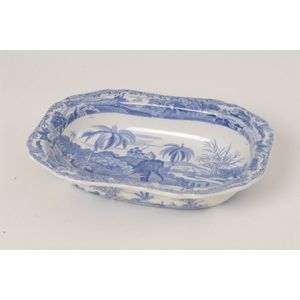Spode Sporting Dish with Hunting Scenes
Spode, Indian sporting rectangular dish, early 19th century, ___1356B250-BFAf-25B7-0A4DB8BB0D62BE0B___ with blue underglaze transfer decoration of 'Hunting a Civet Cat', impressed and blue Spode mark, scene's title and workman's mark, with matching rectangular plate, and a rectangular plate decorated with 'Exhibition of a Battle between a buffalo and a Tiger', marked, restored (A/F) (3), height 4 cm width 24 cm depth 17 cm; width 26 cm; width 23.5 cm. Provenance: Private Collection, Sydney
You must be a subscriber, and be logged in to view price and dealer details.
Subscribe Now to view actual auction price for this item
When you subscribe, you have the option of setting the currency in which to display prices to $Au, $US, $NZ or Stg.
This item has been sold, and the description, image and price are for reference purposes only.
- Earthenware - A basic ceramic material that is fired at a low temperature. Earthenware is the basis of almost all ancient, medieval, Middle Eastern and European painted ceramics. After firing, the colour is the colour of the clay when it is dug from the ground: buff, brown and red. It is not waterproof until glazed. Creamware is a type of earthenware covered with a transparent lead glaze. Majolica, faience and delft are also earthenware covered in an opaque white tin glaze.
- A/f, as Inspected - The letters "A/F" or "as inspected" as part of a description is the cataloguer's shorthand for "all faults" or "as found", meaning the item has some type of damage or deficiency, it is of uncertain date or provenance, and/or that the seller takes no responsibility for the completeness of the item or the accuracy of the description.
- Transfer Printed / Decorated Transferware - Transfer printing is method of decorating ceramics, reducing the cost of decoration when compared to employing artists to paint each piece. A print was taken on transfer-paper from an engraved copperplate, covered in ink prepared with metallic oxides, and the image on the paper was then applied to the biscuit-fired ceramic body. The print was fixed by heating the object in an oven, and then glazed, sealing the picture. Early transfer prints were blue and white, as cobalt was the only colour to stand firing without blurring. Early in the 19th century advances in the composition of the transfer paper resulted in better definition and detail, and enabled engravers to combine line-engraving with stipple.
This item has been included into following indexes:
-
Copeland Spode (England), item types
- dishes and bowls 168
- plates 184
- plates and platters 227
- Copeland Spode (England), patterns - Buffalo pattern 5
